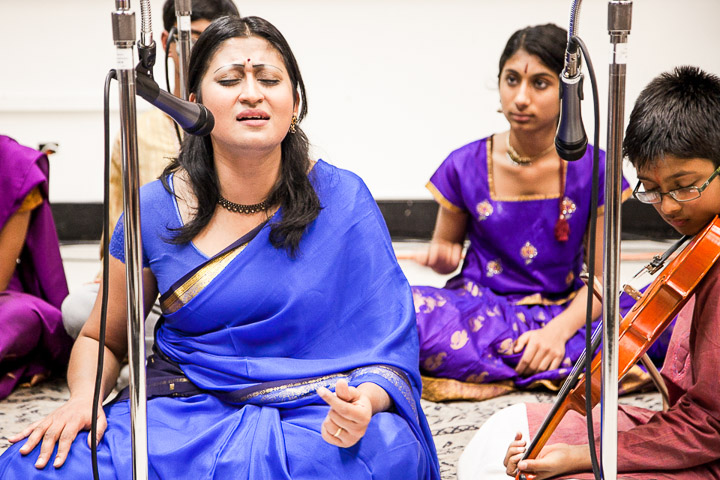World renown vocalists share 3,500-year-old music

By Jackson Ly/The Guardsman
The sound of micro notes, melancholy phrases and ancient instruments filled City College’s Art Room 133 on Nov. 6 as a tradition that began during the Vedic times from 1500 to 1200 B.C. and continues to this day.
Internationally-known South Indian classical vocalist Harini Krishnan lectured and performed Carnatic music, a South Indian classical music, for about 55 attendees.
She was later joined by guest percussionist Rohan Krishnamurthy, who accompanied Krishnan in the concert portion of the event.
Both are trained in Carnatic music and want to develop a global awareness of South Indian classical music.
During the lecture Krishnan demonstrated the presence of micro notes as a Carnatic music system of associating each note of a scale with a particular syllable.
Micro notes are the variations within a note of the musical scale do, re, mi, fa, so, la, ti, do. The first and fifth notes remain constant, but the other notes have variations.
Krishnan said the variations enable different combinations of melodic arrangements called ragas to be created.
Each raga has a specific set of ascending and descending notes, but is much more than just an arrangement of notes, she said. Ragas evoke different moods ranging from melancholy to euphoria and each raga has its own character.
The closest Western musical comparison to Carnatic music is jazz because both require the musicians to improvise as they perform.
Collaborating musicians from different backgrounds must find the right blend to make good music. Krishnamurthy said the best way to bring different traditions together is to learn about other traditions.
“I think music really has this potential to bridge communities in an unprecedented way,” Krishnamurthy said. “The more you know about other traditions, the more you’re aware of similarities and differences.”
Krishnamurthy plays the mridangam, a 2000-year-old Indian drum, has performed in jazz ensembles and orchestras and has a Ph.D. in musicology and ethnomusicology from the Eastman School of Music.
A person who has a clear understanding of “how music is created” and “how music is constructed” will become a better artist, Krishnamurthy said. “It’s just invaluable for any musician because you will have a clear foundation and components of how music is put together.”
Most Carnatic music is based on the Hindu scriptures and Vedic theology. While both Carnatic and Western music focus on rhythm and melody, South Indian classical music requires more improvisation.
Musical learning starts early
“Improvisation makes it harder because you have to think up new ideas while you’re playing,” Keshavan Srivatsan, Krishnan’s 11-year-old nephew who played the violin at the event, said. “Just because you practice at home doesn’t mean you can perform on stage.”
Srivatsan has experience with Western music, and as a seventh grader at Rolling Hills Middle School in Los Gatos has played in concerts both in the Bay Area and in classical Indian style with his aunt.
Srivatsan began his training in Carnatic music at two and began playing the violin at six. He said playing Carnatic music requires more thinking than Western music.
Krishnan started singing and performing when she was six years old. She toured Europe and the United States in 1979 with her sisters.
In India they were called the California Sisters. In Europe and the United States they were known as the Krishnan Sisters.
Krishnan is primarily a disciple of her father, Thiruvaiyaru Krishnan. She grew up in Europe during her elementary and middle school years and traveled to India every summer when she was six to eight-years-old.
She received advanced training under Dr. S. Ramanathan, an eminent musician and musicologist, in the teacher-disciple tradition characteristic of Indian music’s Guru-Shisya Parampara.
“The relationship between a disciple and guru is considered sacred,” Krishnan said. “Only when you completely surrender your ego to the guru and imbibe humility, you are ready to begin the process of learning.”

Comments are closed.